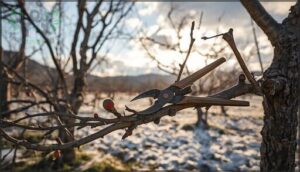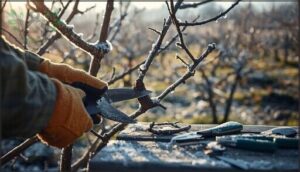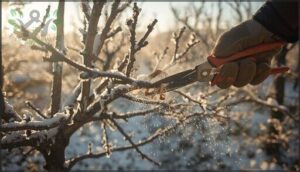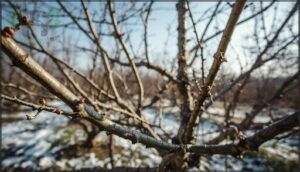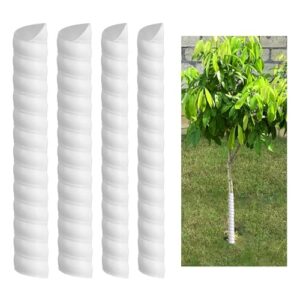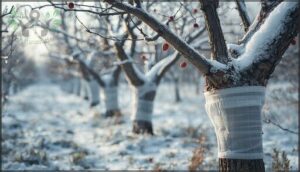This site is supported by our readers. We may earn a commission, at no cost to you, if you purchase through links.
The first hard frost doesn’t just signal the end of your tomato harvest—it’s a wake-up call for fruit tree owners. Too many healthy trees limp into spring weakened by winter stress, not old age or disease. If you’ve ever watched a once-thriving apple or peach tree struggle after a cold snap, you know the sting of preventable damage.
The truth is, winter fruit tree care isn’t just about surviving the cold; it’s about setting the stage for next year’s growth and fruiting. With a few targeted steps, you can protect your investment and give your trees the best shot at a vigorous spring.
Table Of Contents
- Key Takeaways
- Preparing Fruit Trees for Winter
- Winter Pruning Techniques
- Protecting Tree Trunks and Branches
- Managing Winter Pests and Diseases
- Winter Care for Potted and Young Trees
- Frequently Asked Questions (FAQs)
- How do you take care of fruit trees in the winter?
- Which fruit tree can survive winter?
- Do you water fruit trees in the winter?
- Should you prune fruit trees in winter?
- How do you treat a fruit tree in winter?
- How to care for fruit trees in your garden?
- How can I prevent diseases and infestations in my fruit trees in winter?
- How do you care for a fruit tree in the fall?
- What should I spray my fruit trees with in winter?
- Do you prune fruit trees in winter?
- Conclusion
Key Takeaways
- Deep watering before the ground freezes and insulating roots with organic mulch are essential for protecting fruit trees from winter stress and ensuring strong spring growth.
- Pruning during the dormant season, especially removing dead, diseased, or crossing branches, improves air circulation, reduces disease risk, and sets up healthier fruit production.
- Applying trunk guards and regularly inspecting for storm damage or pests helps prevent sun scald, frost cracks, and infestations that can weaken trees through winter.
- Consistent sanitation—clearing debris, fallen fruit, and pruning with sterilized tools—greatly reduces pest pressure and disease carryover into the next growing season.
Preparing Fruit Trees for Winter
Getting your fruit trees ready for winter starts with a few essential steps. Each one helps protect your trees and sets them up for healthy growth next spring. Here’s what you’ll want to focus on as the cold weather approaches.
Assessing Tree Type and Hardiness Zone
Clarity in Tree Identification is your first step—knowing whether you have Deciduous Trees like apples or Evergreen Trees such as citrus shapes your winter prep.
Use the USDA Plant Hardiness Zone Map and Zone Mapping to match Fruit Variety to local Hardiness Zones. Climate Analysis and understanding required Chill Hours guarantee your Fruit Trees thrive, not just survive, through winter.
Understanding AP study resources can also boost your knowledge of science subjects like botany.
Removing Debris and Fallen Fruit
Once you’ve matched your fruit trees to their hardiness zone, shift focus to Debris Removal and Fruit Sanitation. Clearing fallen fruit and leaves from around trunks isn’t just tidy—it’s Orchard Maintenance that slashes pest pressure by up to 40% and reduces disease risk.
This simple Winter Care step bolsters Tree Health, readies your site for effective Pruning, and keeps pests at bay.
Deep Watering Before Ground Freezes
After you’ve cleared debris, turn your attention to Soil Moisture Management. Deep watering—aiming for 12–18 inches—before the first hard freeze is a proven Winter Watering Strategy.
This method:
- Boosts root zone hydration for steady winter moisture
- Enhances carbohydrate reserves for spring vigor
- Reduces frost risk by improving soil’s thermal mass
It’s the backbone of smart Winter Tree Care. Effective research involves using subtopic skills to organize information.
Insulating Roots With Organic Mulch
Once you’ve watered deeply, it’s time to think about root insulation. For reliable winter protection, spread organic mulch—like shredded bark or straw—2–4 inches deep around the drip line.
This Mulch Depth buffers soil temperature, keeping roots stable during cold snaps. Just remember: keep mulch away from the trunk to prevent rot. It’s a simple, proven step in winter fruit tree preparation.
Winter Pruning Techniques
Winter is the ideal time to shape and strengthen your fruit trees. Careful pruning now sets the stage for healthy growth and better harvests next season. Here’s what you need to know before you start.
Best Time to Winter Prune
Timing your Fruit Tree Pruning is like catching the perfect tide—you want to work during the dormant season, just before buds swell but after the harshest cold has passed. For most deciduous trees, late winter to early spring is ideal.
This window, when Winter Chill requirements are met and Cold Hardiness is highest, sets the stage for healthy spring growth.
Making a Pruning Plan
A thoughtful pruning plan is your blueprint for winter tree care success. Start with a Tree Assessment, noting structure and health. Pruning Strategies should target canopy management and future growth, not just appearance. Gather sharp pruning tools and map your approach—Branch Selection is key for balanced, productive fruit tree pruning.
- Assess structure and vigor
- Define canopy management goals
- Prepare and inspect pruning tools
Removing Dead or Diseased Wood
Precision is your ally during Winter Wood Care. Dead Branch Pruning and Diseased Wood Removal limit infection courts by up to 60%, preserving tree vigor. Always cut to healthy tissue, using sterilized tools for every Tree Pruning and Trimming session. This approach speeds Tree Wound Healing and strengthens Fruit Tree Maintenance throughout the Dormant Season.
| Symptom | Action | Benefit |
|---|---|---|
| Dead branches | Prune to healthy wood | Reduces infection risk |
| Dark lesions | Remove entire section | Stops disease spread |
| Tool sanitation | Sterilize between cuts | Prevents cross-infection |
Eliminating Crossing and Crowded Branches
Crossing Removal isn’t just tidying up—it’s a cornerstone of smart Fruit Tree Care. Left unchecked, crowded branches invite disease and bark wounds.
With deliberate Branch Pruning and Tree Training, you’ll open the canopy, reduce future pruning loads, and set the stage for healthier growth.
Pruning Strategies that target crossings guarantee your Winter Tree Care delivers lasting structure and vigor.
Pruning for Air Circulation and Sunlight
Imagine your fruit tree as a living solar panel—without the right Pruning Techniques, its energy gets blocked. By opening the canopy, you boost Air Circulation and Sunlight Penetration, directly improving Fruit Yield and Tree Structure.
Pruning your fruit tree opens its canopy, letting in air and sunlight to boost both its energy and your harvest
Smart winter Pruning isn’t just Tree Maintenance; it’s the backbone of effective Fruit Tree Care, setting the stage for healthier, more productive seasons ahead.
Protecting Tree Trunks and Branches
Winter can be tough on fruit trees, especially their trunks and branches. Protecting these vulnerable parts now helps your trees stand strong through the coldest months. Here’s how you can give them the best defense this season.
Using Tree Trunk Protector Guards
Did you know a well-fitted tree guard can boost frost protection and reduce sunburn by over 50%? Guard installation isn’t just about wrapping—it’s essential cambial care.
Use breathable tree guards or wraps as your trunk sunscreen, and pair with mulch for sturdy winter tree care.
For young trees, combine trunk protection with a rabbit fence for complete fruit tree protection.
Preventing Sun Scald and Frost Cracks
Trunk Protection is your best ally against Sun Scald and Frost Cracks. Thin-barked fruit trees, like apples and cherries, benefit most from Bark Insulation. For effective Frost Prevention and Cambium Care, remember:
- Apply white tree guards for maximum reflectivity
- Use breathable wraps to avoid moisture buildup
- Pair trunk protection with mulch for Winter Care
- Inspect guards biweekly to maintain Tree Protection and limit Frost Damage
Clearing Broken or Downed Branches After Storms
While trunk guards shield against sun scald, storms can leave a trail of broken limbs and scattered debris. Storm damage isn’t just unsightly—it invites pests and disease.
Prioritize debris cleanup within 24–72 hours. Use proper branch removal and pruning techniques, making clean cuts close to healthy wood.
Regular tree inspection helps you catch winter damage early, strengthening your winter tree care routine.
Managing Winter Pests and Diseases
Winter brings its own set of challenges for fruit trees, especially regarding pests and diseases. Staying on top of these issues now will help your trees thrive once spring arrives.
Here’s what you should focus on during the colder months.
Identifying Common Winter Pests
Pest inspection is your frontline defense in winter tree care. Aphids, scale insects, and spider mites often overwinter in bark crevices, while winter moths and borers emerge unpredictably.
Rodent control is vital—bark damage from mice and voles can reach 12% in some orchards.
Stay vigilant for fungal infections, as latent pathogens exploit prune wounds and residual wood.
Applying Dormant Oil Sprays
Once you’ve spotted overwintering pests, Dormant Oil Benefits become clear—this winter treatment targets scale, mites, and aphid eggs before spring. For effective Pest Control Methods, spray application should cover every twig “to the point of runoff.” Remember:
- Use recommended oil concentration rates (1–4%)
- Apply during the dormant season before buds swell
- Avoid freezing or rainy weather for best results
Maintaining Sanitation to Prevent Disease
With winter tree care, Sanitation Methods become your frontline defense. By removing fallen fruit and pruning debris, you’re cutting pest carryover by up to 70% and lowering fungal disease pressure.
For effective Disease Prevention, hot compost or mulch debris for maximum Pathogen Reduction.
Clean your tools between cuts—this simple step aids Fruit Tree Health and strong Disease Control all season.
Inspecting for Overwintering Insects
A sharp eye during Winter Inspections is your best tool for Insect Identification and Dormant Pest Management. Look closely at branches and buds—scale insects and codling moth egg masses often hide in plain sight.
Mechanical removal now, paired with regular Fruit Tree Monitoring, tightens your Pest Control Methods and strengthens Tree Health and Wellness for spring’s new growth.
Winter Care for Potted and Young Trees
Young and potted fruit trees need extra attention when winter rolls in. Their roots and tender branches are more vulnerable to cold snaps and sudden changes.
Here’s how you can give them the best protection this season.
Storing Potted Trees in Sheltered Locations
Did you know that moving potted fruit trees into Sheltered Storage can cut root freeze risk by more than half? For effective Potted Tree Care and Winter Protection, place containers in garages or sheds where temperatures stay above -5°C. South-facing spots boost light and photosynthesis.
This simple step in Winter Gardening is vital for Frost Prevention and successful Winter Tree Care.
Insulating Pots With Mulch or Burlap
Think of Mulch Depth and Burlap Wrapping as a warm quilt for your fruit trees’ roots. A 2–4 inch layer of mulch stabilizes soil temperature, while burlap insulation cuts heat loss by up to 35%. These insulation materials boost root protection, reduce freeze-thaw stress, and keep your winter care routine solid.
- Maintain 2–4 inch mulch depth
- Use burlap for extra insulation
- Keep mulch off the trunk
- Choose coarse organic mulching
Monitoring Soil Moisture in Containers
Ever notice how uneven watering can sabotage even the best tree care? Root Zone Monitoring with Soil Moisture Sensors is your secret weapon. Aim for 15–25% Volumetric Water Content—too much, and roots suffocate; too little, and stress sets in. Pair Water Retention Strategies and Mulch Depth Optimization for steady soil temperature and moisture.
| Practice | Benefit |
|---|---|
| Soil Moisture Sensors | Accurate watering |
| Mulch Depth Optimization | Improved retention |
| Root Zone Monitoring | Healthier roots |
| Watering adjustments | Prevents root rot |
Addressing Issues Promptly to Prevent Damage
Rapid Intervention is the backbone of effective Winter Care for potted and young trees. Miss a sign of frost damage or pest activity, and problems can snowball fast. Regular Tree Monitoring and Winter Inspections let you catch issues early—think of it as damage control for your tree’s future.
- Peace of mind with prompt pruning
- Fewer surprises from pest and disease management
- Stronger tree health through vigilance
Frequently Asked Questions (FAQs)
How do you take care of fruit trees in the winter?
Winter care for fruit trees means focusing on root protection, deep watering before the ground freezes, and applying organic mulch.
Pruning during the dormant season and monitoring for pests ensures healthy fruit tree nutrition, sufficient winter chill hours, and resilience against frost damage.
Which fruit tree can survive winter?
Apple, pear, and cherry trees stand out for their frost tolerance and cold climate adaptation, thriving in hardiness zones as low as 3 or
Proper winter tree care and understanding fruit tree hardiness help your deciduous trees survive harsh winters.
Do you water fruit trees in the winter?
Yes, you should water fruit trees in the dormant season, especially during dry spells.
Winter irrigation maintains soil moisture, promotes root health, and aids frost protection.
Deep, infrequent watering conserves water and strengthens fruit trees for spring growth.
Should you prune fruit trees in winter?
Pruning during the dormant period offers clear benefits—removing weak growth boosts tree resilience and future fruit yield.
Tackle this task mid-to-late winter, when fruit trees are least vulnerable to winter damage, optimizing your winter tree care strategy.
How do you treat a fruit tree in winter?
Don’t let your fruit trees freeze their “roots” off—treat them with deep watering, root insulation, and careful pruning.
Focus on Fruit Tree Nutrition, monitor Winter Chill Hours, and use mulch for reliable Frost Protection and Winter Tree Care.
How to care for fruit trees in your garden?
Caring for fruit trees in your garden starts with smart Fruit Tree Selection, careful Soil Preparation, and a thoughtful Garden Layout.
Prioritize Tree Nutrition, adapt to local Climate Considerations, and use consistent Tree Care routines to boost Fruit Production.
How can I prevent diseases and infestations in my fruit trees in winter?
To boost fruit tree health in winter, focus on disease prevention and pest control. Apply dormant oil sprays, practice winter sanitation by removing debris, prune for air circulation, and inspect bark for overwintering pests—key steps for cold climate management.
How do you care for a fruit tree in the fall?
You might think fall is too early for Winter Preparation, but it’s the foundation for healthy Fruit Trees.
Focus on Fruit Tree Selection, Root Protection with mulch, Fall Fertilization, proper Tree Wrap Methods, and timely Fall Pruning for ideal Tree Care.
What should I spray my fruit trees with in winter?
In winter, spray fruit trees with Dormant Oil or Horticultural Oils for pest control, and use copper-based fungicide options to manage diseases.
Apply during the dormant season, after pruning and training, for effective winter care and healthy spring growth.
Do you prune fruit trees in winter?
Imagine skipping winter pruning—your fruit trees would become wild tangles, robbing you of healthy Fruit Yield.
Yes, you absolutely prune fruit trees in the dormant season, using sharp Pruning Tools and proper pruning techniques to boost Cold Hardiness and tree health.
Conclusion
Inspecting, pruning, protecting—each step in winter fruit tree care gives your trees a fighting chance against the season’s harshest tests. When you clear debris, guard trunks, and monitor young roots, you’re not just preventing damage; you’re investing in next year’s bounty.
Consistent attention now means fewer springtime surprises and stronger, more resilient trees. Think of winter as your silent partner—working with you to build a foundation for growth, health, and a harvest you can truly count on.
- https://www.sjsu.edu/writingcenter/docs/handouts/Methodology.pdf
- https://learn.orchardpeople.com/researching-fruit-trees-for-organic-growing-success
- https://files.eric.ed.gov/fulltext/ED536788.pdf
- https://www.reddit.com/r/SeriousConversation/comments/1nsbc3y/what_does_your_process_look_like_when_researching/
- https://mobile.collierschools.com/research/3%20Organize%20Information/3-1%20Identify%20Subtopics.html


